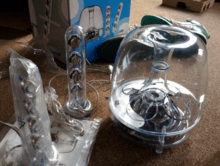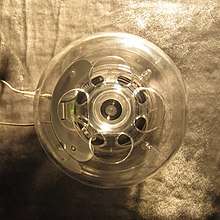SoundSticks
SoundSticks are multimedia speakers sold by Harman Kardon, originally co-developed with Apple Inc. They were released in July 2000. They are a 2.1 system with a pair of satellite speakers and a subwoofer called the iSub, which was originally available first in October 1999 as a standalone product. They were designed by Jony Ive and have received numerous accolades for their industrial design.


.jpg) SoundSticks and iSub | |
| Developer | Harman Kardon Apple Inc. (original model) |
|---|---|
| Manufacturer | Harman Kardon |
| Type | Multimedia speakers |
| Introductory price | US$99 (iSub) US$199 (SoundSticks) |
| Sound | 4 drivers per satellite, attached woofer |
| Connectivity | USB audio (original) 3.5mm jack (SoundSticks II and newer) Bluetooth (SoundSticks Wireless) |
| Dimensions | 10 in × 2 in (254 mm × 51 mm) (satellite speakers) 16 in × 16 in (410 mm × 410 mm) (iSub) |
| Mass | 1.5 lb (0.68 kg) (satellite speakers each) 4 lb (1.8 kg) (iSub) |
| Website | www |
Development
Harman Kardon's partnership with Apple dates back to 1999 when they provided Odyssey stereo speakers built into the iMac G3. In October 1999 Steve Jobs announced the iSub, a 6-inch subwoofer that connected over USB and was only compatible with slot-loading iMacs G3s and PowerPC Macs with Apple Pro Speakers, not working on the later Intel-based Macs.[1] Apple introduced a software implementation to adjust the frequency range of the iMac's internal speakers so they would not overlap with the iSub, and increased the iMac's maximum volume as the speakers no longer had to produce deep bass.[2] It retailed for $99.[3][4] It was designed by Jony Ive, and used clear plastic to match the aesthetic of Apple's product line at the time. Ive designed it like a wind instrument so "sound could flow freely."[5][6]
Harman Kardon and Apple next designed SoundSticks, a 2.1 system with a new revision of the iSub, which were introduced at the July 2000 Macworld expo.[7][8] Apple led the industrial design and mechanical engineering to have them fit into its product family. The satellite speakers used Odyssey speakers similar to those in the iMac G3 and feature four drivers. Plug-and-play support for SoundSticks was added in Mac OS 9.0.4.[9] SoundSticks were available along with the similarly-designed Pro Speakers, which were also designed by Harman Kardon in collaboration with Apple, but were branded as an Apple product.[10]
SoundSticks II were released in 2004, adding capacitive volume control buttons and a 3.5mm mini-jack input, replacing the previous USB input, and adding a blue LED to the iSub.[11] SoundSticks III were released in 2009 and changed the styling slightly using black highlights, instead of green and blue of the original SoundSticks and the SoundSticks II, and changed the color of the LED in the iSub to white.[12][13] SoundSticks Wireless were introduced in 2012 and added Bluetooth connectivity.[14] Harman Kardon carried over the iSub's design for their Aura line of all-in-one speakers.[15]
Apple retailed SoundSticks as late as 2015 but has since removed them from their store.[16] They are still sold by Harman Kardon.
Reception
SoundSticks won an Industrial Design Excellence Award in 2000[17] and were featured on the cover of I.D. magazine.[18]
Reviews for SoundSticks were generally positive. In 2001 The Mac Observer noted "the sound is crystal clear without audible distortion" and produced strong results for music and movies, but criticized the price as being higher than comparable or superior systems.[19] In 2002 CNET rated them four stars, praising the easy setup, design, and audio quality, but criticized the lack of physical controls and the limited support for Windows-based computers.[20] A 2011 review was also positive, but criticized the lack of a headphone input and noted the iSub LED could not be turned off without turning off the entire system.[21]
A 2019 retrospective by Forbes praised them as having "a classic piece of kit that's stood the test of time and is as good today as when it was introduced" and "still have the look of an iconic industrial design, almost two decades on", and noted their current retail price was lower than when they launched almost 20 years earlier.[22] A review by Wired from August 2013 was mixed, rating them 5 out of 10 points, criticizing the placement of the controls and the Bluetooth reliability.[23]
Appearances in media and as artwork
In 2013 the Museum of Modern Art in Manhattan added an iSub to its collection.[24]
SoundSticks were prominently featured in the 2013 film Begin Again.[25]
See also
References
- Harman Kardon iSub (Apple USB Subwoofer) | IMNC, retrieved 2019-10-09
- "Harman/Kardon Mac Compatibility Guide". Low End Mac. 2001-05-31. Retrieved 2019-10-08.
- Poma Ads: Special Event Cupertino (1999) 3/6, retrieved 2019-10-07. Event occurs at 7:31.
- "Jobs Splits iMac Line over Digital Video". TidBITS. 1999-10-11. Retrieved 2019-10-07.
- La, Lynn. "Jony Ive's 15 most iconic Apple products and designs". CNET. Retrieved 2019-10-07.
- "SoundSticks Wireless Review: The 'Apple iSub' Is As Elegant And Powerful As Ever, But 'Wireless' Is Another Story". International Business Times. 2013-03-12. Retrieved 2019-10-07.
- ALLBRITTON, CHRIS. "MAC- stravaganza Apple's new product line is more polished than ever". nydailynews.com. Retrieved 2019-10-07.
- "Harman Kardon History". Archived from the original on 2015-02-27. Retrieved 2015-02-25.
- "SoundSticks". Macworld. 2000-11-01. Retrieved 2019-10-07.
- Steeber, Michael (2018-03-19). "Revisiting the forgotten history of obscure Apple accessories". 9to5Mac. Retrieved 2019-10-07.
- Gideon, Tim. "Harman/Kardon SoundSticks II review: Harman/Kardon SoundSticks II". CNET. Retrieved 2019-10-07.
- "Harmon Kardon Soundsticks III: minor update to design classics". SlashGear. 2010-07-15. Retrieved 2019-10-07.
- SoundSticks page Retrieved on 2011-08-11 Archived August 5, 2011, at the Wayback Machine
- SoundSticks page Review: Harman Kardon SoundSticks Wireless at the Wayback Machine (archived April 4, 2016)
- Greenwald, By Will; July 14, 2014 9:01AM EST; July 14, 2014. "Harman Kardon Aura". PCMAG. Retrieved 2019-10-13.CS1 maint: numeric names: authors list (link)
- "Speakers - All Accessories - Apple Store (U.S.)". web.archive.org. 2015-03-30. Retrieved 2019-10-07.
- "iSub: Gold, Consumer Products". Industrial Designers Society of America. Archived from the original on 2003-12-07. Retrieved 6 December 2014.
- "All You Need To Know About Harman Kardon Before You Buy Those Speakers". Que Mag. 2018-02-15. Retrieved 2019-10-07.
- "The Mac Observer - Review - SoundSticks, Crystal Clear And Crystal Looking". www.macobserver.com. Retrieved 2019-10-09.
- Steinberg, Gene. "Harman Kardon SoundSticks review: Harman Kardon SoundSticks". CNET. Retrieved 2019-10-09.
- Yu, Justin. "Harman Kardon SoundSticks III review: Harman Kardon SoundSticks III". CNET. Retrieved 2019-10-09.
- Sparrow, Mark. "Harman Kardon Soundsticks Are Still The Ideal Apple Mac Partner Some Two Decades On". Forbes. Retrieved 2019-10-09.
- Bellamy, Seamus (2013-08-28). "Review: Harman Kardon SoundSticks Wireless". Wired. ISSN 1059-1028. Retrieved 2019-10-07.
- Leswing, Kif. "These Beautiful Speakers Are Your Jony-Ive-Designed-MoMA-Approved Deal of the Day". Gizmodo. Retrieved 2019-10-07.
- "Product placement in pictures: Begin Again". Brands & Films. 2014-10-06. Retrieved 2019-10-07.